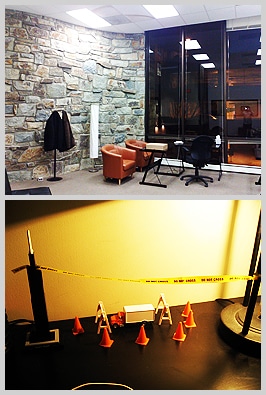Every so often there comes a time when you, as a designer, really need a solid system to help you keep track of everything creative in a large scale project, especially if the project involves a lot of people and everyone is trying to stay updated with what’s going on and who’s doing what etc… This is usually when companies start looking for an easier solution to manage things, a way to manage their large number of creatives so to speak. That’s the time when you should take a look at PageLime.
The team behind PageLime is a couple of guys as rad and mad as most of our visitors, all in a good way. To solve a problem that is causing you to lose money is a lot harder than you sometimes think and that’s what makes these guys unique. Instead of trying to find a content management system that could potentially work for them, they instead set out on a journey to create their own. The result was so successful that they decided to make it available for everyone else as well.
Their names? Simple and short Tom and Emil. When I heard about this CMS service I just had to check it out to see what all the fuzz was about. I managed to get an interview with them which grew into a sort of “behind the scenes” article and I was thrilled about the product they had created.
Being a designer/programmer myself, I am sure that their service along with their story is going to inspire many of our readers to take a closer look at PageLime and also perhaps save a bundle of money on your own content management system needs.

We both came from a web development freelancing background. Time and time again we would run into problems related to content management for smaller sites. These sites made up the bulk of our revenue, but also tended to have the least tech savvy operators. After installing WordPress on sites with 7 pages, custom building CMS that took longer then the actual site design, and always having to under quote our budgets to come in with estimates that were economically feasible for the client we got fed up, and PageLime was born.
2. How long did it take you to go from idea to your first signed up user and what do you think as the most difficult segment in starting PageLime?
It took us about a year. Emil had taken a full time job and I was still freelancing so we built the system in the empty spaces that were supposed to be filled with relaxation and social lives. The most difficult segment was really narrowing down what the core functionality had to be, something a kin to a Commanders Intent message. In our case we chose to focus on simplicity and benefits to our users. So no matter what we add to the system or how it grows, initially you will always have a core product that remains extremely easy to use and effective at simple editing. Turning on all of our more complex features is up to you.
3. Can you share with us what your day to day activities are at PageLime and also how many people are working behind the scenes at PageLime?
Currently PageLime is Emil, Tom, and our intern/junior associate Adam. We start the day answering emails from our Australian and UK users that have already been hard at work hours before we even start. Then I move on to sending personal welcome messages to all of our new users that have signed up over the night. Most of the day consists of the team laughing around the office, working on PageLime upgrades and client support, breaking to watch some random TV show on our fileserver, and then crushing lemons with our bare hands in ritualistic sacrifice to our Lime overlords.
 4. Reading up on PageLime it strikes me a very well balanced online tool for any developer/designer. What do you think most subscribers enjoy the most about PageLime and where do you think you could close the gap between your service and the users expectations?
4. Reading up on PageLime it strikes me a very well balanced online tool for any developer/designer. What do you think most subscribers enjoy the most about PageLime and where do you think you could close the gap between your service and the users expectations?
I think the majority of users like the overall simplicity of using the tool when explaining it to their clients. Clients just get it, they don’t have to fill out forms, or look at text boxes they correlate to some page on their websites. They see their webpage getting updated live in front of them, without any doubt as to what is going on.
In terms of managing user expectations, I think many people have an issue with using a hosted service for managing their content. I personally think it is the best way to go. First with PageLime’s architecture you aren’t tied to us for your websites stability. Instead of having 2 points of failure with a database and your host, now you only have to worry about your host. We push all the changes then walk away. Not being tied to PageLime means you can not only have less to worry about in regards to site stability, you get easy growth if a site needs to expand. Just stop using PageLime and integrate an enterprise solution. No porting, no pressure, no problems.
5. Can you give us a scenario where using PageLime could heavily increase work speed while the developers and designers still retain full control of their project and does it work using it as a developer group?
We have many users who setup the framework of their sites ahead of time. Creating what amounts to wireframes for their clients that have all the html raw code and blocking, but none of the actual graphic design, CSS UI, or scripting. They set their clients up with PageLime so they can do all of the copy editing an insertion ahead of time, taking both the responsibility for correct copy and the need for dummy copy removal at the end of the project away. For example Jessica over at sorcadesign.com does an amazing job of this, gets her projects completed faster and in turn her clients are happier.
It also works just fine within a developer group with the business account, where you can have multiple site administrators managing the sites across the board. PageLime also has versioning and content history so any destructive changes can be rolled back to the last proper publish.
 6. How many active subscribers/users does PageLime have today and what do you do to further spread the word about PageLime’s most beneficial features?
6. How many active subscribers/users does PageLime have today and what do you do to further spread the word about PageLime’s most beneficial features?
We’re currently in the mid thousands as of December 14th 2009 and growing rapidly. We do a lot of twitter marketing and love doing giveaways when we release new features. Besides that we don’t do much, we have fantastic users who spread the word and our extremely high levels of customer support keep our retention rates high.
7. Talking about features, what do you think is the strongest point and feature that PageLime has and do you have any plans on adding more features in the future and what can we expect them to be?
I think our strongest feature at the moment is repeating regions. No other so called “Light” or “Simple” CMS has the ability to do more then just edit regions. With PageLime you actually have the ability to create content based off of those regions. You can create new navigation buttons, blog style posts, event boxes with full styling and images, and news feeds. These are all kinds of content that you normally could only do with a larger CMS. We also work with page includes across most major coding languages. This allows you to do dynamic pages and content blocks that can be included across the whole site. Another feature only PageLime offers.
We have a roadmap for the future:
Client Invoicing – We’re building an invoicing feature from withing PageLime that will let you manage your PageLime clients with auto recurring invoices that link to your PageLime account. This basically allows you to setup a subscription model for you clients, and pass the cost of PageLime directly to them. OR charge them more, and make money off of PageLime!
Language Internationalization – PageLime will be available in the language of your choosing, and if not the entire systems menu and information can be edited by you so it can appear in the language of your clients.
Blog – Drop in simple PageLime managed blog.
iPhone App – Manage websites from an iPhone application. This is already designed, just need to go about building it soon.
eCommerce – Either a partnership with another team, or build one ourselves that can be dropped in, like the blog.
 8. What have been the highlights at PageLime to date and what is your goal with this really powerful tool in the future?
8. What have been the highlights at PageLime to date and what is your goal with this really powerful tool in the future?
I think the day we had our first user go PRO was pretty fantastic, because a lot of people tried to convince us that no one pays for anything on the Internet anymore. It proved that if you develop a service that is well thought out, solves a problem, and can actually save people time and make them more money they would pay for it. Our goal in the future is to continue to meet our feature targets, and to continue to always put our users first by implementing beneficial features and continuing our extreme support. I know these all sound corny, but we sit here all day, we read every email by hand, and we just stand by all of our stuff.
9. Who are your closest competitors and what makes PageLime better than them?
I think out closest competitors are really people who go the homegrown CMS route. So many people like to really get into the code and get their hands dirty and do everything from scratch. It’s hard to convince people it would be better to save time and make more money with PageLime if they are predisposed to working harder and less effectively for their clients.
 10. If you could use any other online application in collaboration with PageLime which one would be the most compatible one and why?
10. If you could use any other online application in collaboration with PageLime which one would be the most compatible one and why?
I would suggest using FoxyCart with PageLime. Great team over there. They are certainly the easiest e-commerce solution to integrate. It works seamlessly with PageLime and they are developing a full API that we will most likely be integrating into PageLime for central a centralized e-commerce solution built into PageLime.
Odd Facts
1. We’re sponsored by Vitamin Water, and we consume tons of them every day as you can see from the attached picture. (We’re not kidding, we get this stuff delivered by the truck load)
2. There is a sandwich named the PageLime Panini at Visions, a restaurant around the corner from us. https://www.visionsbethesda.com.
3. We’re secretly involved in a massive revolution to have Lime come first in all products from now on. You can read the story of how all this came about at https://www.itislimetime.com/sidescroll.php.
4. Tom thinks he has a really good Emil accent (Croatian) but in fact all of his accents just sound like a horrible combination of Borat and Sylvester Stallone.
5. We have a dog in our office named Jackson. Occasionally he likes to get dressed for work, in his best Lime ties.
6. People often ask where the name of PageLime came from. It was Emil’s idea, and Tom loved it (because limes are flippin’ awesome). One day Tom realized it was just Emil spelled backwards with “Page” in front. Emil snuck this past Tom until well after the trademark was filed. Tom has come to terms with this but expect our next product to end in ‘Mot’.
COMMENTS